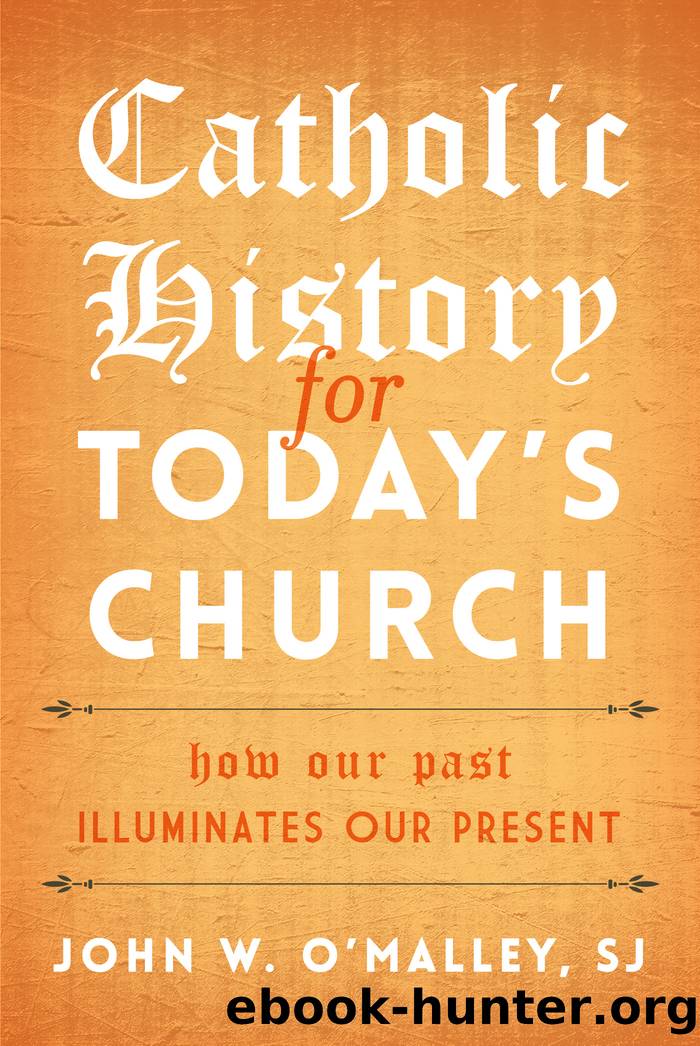Catholic History for Today's Church by John W. O'Malley

Author:John W. O'Malley
Language: eng
Format: epub
Tags: undefined
Publisher: Rowman & Littlefield Publishers
Published: 2012-09-15T00:00:00+00:00
Center-Periphery Relations
Collegiality brings us to the heart of the second issue-under-the-issues at Vatican II, the relationship between center and peripheryâhere, between papal primacy and the authority of residential bishops at the periphery (that is, at their local sees). Yet it is impossible adequately to speak of collegiality without at the same time speaking of ressourcement. To speak of collegiality, moreover, is implicitly to raise the third issue-under-the-issues, the style in which the church operatesâa monarchical style or a collegial style. Collegiality, the lightning-rod issue at the council, manifests the intimate relationship among the three issues-under-the-issues.
Collegialityâs claim to legitimacy at Vatican II certainly did not surface altogether independently of postwar political developments in Europe. Christian democracy in its parliamentary forms flourished, with the blessing of both Pius XII and John XXIII. Both popes spoke eloquently about how participation in the political process accorded with human dignity and was now a moral responsibility. European and North American bishops came to Vatican II with direct experience of politics by participation. However, collegiality had much better claims on the bishops than the fact that it was a species of aggiornamento in tune with the political correctness of the contemporary West, in tune with âthe signs of the times.â
Ressourcement and development locked horns over collegiality. In the West, papal primacy âdevelopedâ incrementally in a steady and almost continuous line up until the nineteenth century, which is when it accelerated at almost breathtaking speed (for the church!) and resulted in papal definitions of the Immaculate Conception and the Assumption; in the growth and increasing authority exercised by the congregations of the Roman Curia; in the devolution of the appointment of bishops almost exclusively into the hands of the popes; and, of course, in 1870, in the definitions of primacy and infallibility.
Through the centuries in the West, collegiality, on the contrary, had not âdeveloped.â It survived but had entered a slow process of atrophy. It was operative even into the twentieth century in provincial and national synods such as the various Councils of Baltimore in the United States, and it was acknowledged in the fact that the popes addressed their encyclicals to their âvenerable brothers,â the bishops. But the starch was out of it. Now at Vatican II a process of ressourcement or renaissance had retrieved it. Its proponents placed collegiality side by side with papal primacy as defined in Vatican I and packaged the two as compatible, as to a large extent they had been in a much earlier era. In the view of these proponents, which was the view of the vast majority of bishops at the council, collegiality was an enhancement of the primacy and an aid to its proper functioning.
A tiny but unyielding minority at the council did not buy that view. This kind of ressourcement, despite all the fine words of the speakers for the majority, seemed to them to limit the solemn definitions of Vatican I and threaten the way the church operated at the center. Collegiality, in the view of
Download
This site does not store any files on its server. We only index and link to content provided by other sites. Please contact the content providers to delete copyright contents if any and email us, we'll remove relevant links or contents immediately.
| Buddhism | Christianity |
| Ethnic & Tribal | General |
| Hinduism | Islam |
| Judaism | New Age, Mythology & Occult |
| Religion, Politics & State |
Cecilia; Or, Memoirs of an Heiress — Volume 1 by Fanny Burney(32434)
Cecilia; Or, Memoirs of an Heiress — Volume 2 by Fanny Burney(31869)
Cecilia; Or, Memoirs of an Heiress — Volume 3 by Fanny Burney(31852)
The Secret History by Donna Tartt(18843)
Sapiens: A Brief History of Humankind by Yuval Noah Harari(14248)
Leonardo da Vinci by Walter Isaacson(13179)
The Radium Girls by Kate Moore(11921)
Sapiens by Yuval Noah Harari(5293)
How Democracies Die by Steven Levitsky & Daniel Ziblatt(5127)
The Wind in My Hair by Masih Alinejad(5033)
Homo Deus: A Brief History of Tomorrow by Yuval Noah Harari(4822)
Endurance: Shackleton's Incredible Voyage by Alfred Lansing(4676)
The Silk Roads by Peter Frankopan(4456)
Man's Search for Meaning by Viktor Frankl(4420)
Millionaire: The Philanderer, Gambler, and Duelist Who Invented Modern Finance by Janet Gleeson(4374)
The Rape of Nanking by Iris Chang(4136)
Joan of Arc by Mary Gordon(4013)
The Motorcycle Diaries by Ernesto Che Guevara(4009)
Hitler in Los Angeles by Steven J. Ross(3900)
